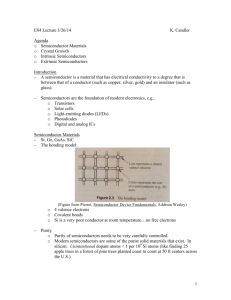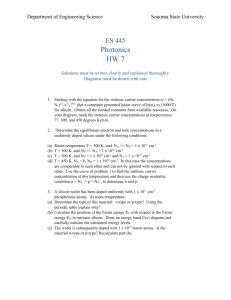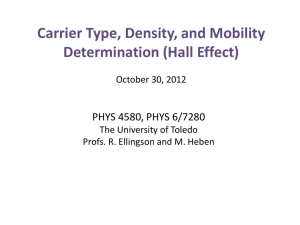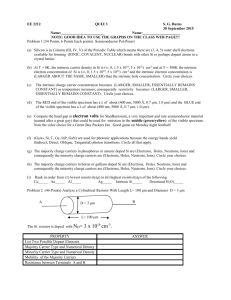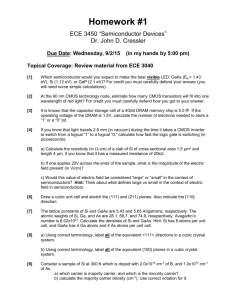Week 10
advertisement
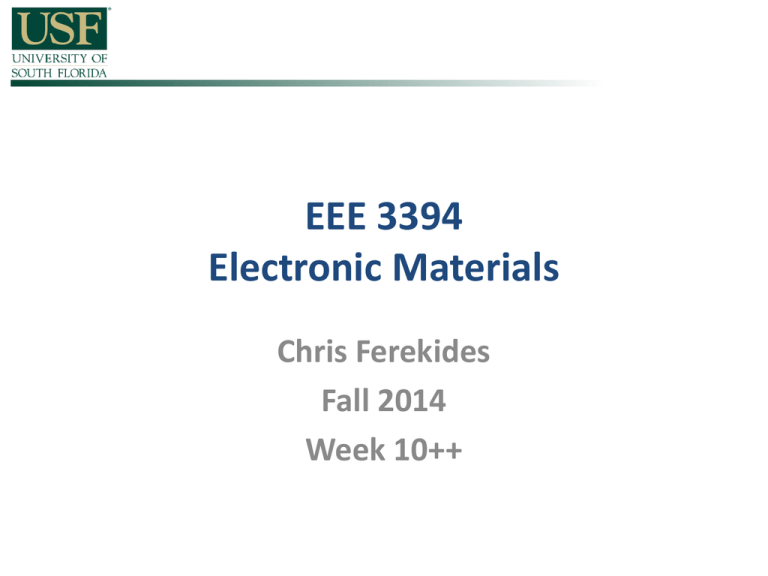
EEE 3394 Electronic Materials Chris Ferekides Fall 2014 Week 10++ Equilibrium Carrier Concentrations REM: gC(E)d(E) f(E) represents the number of available states (cm-3) in the energy interval E+dE. is the probability a state is occupied by an electron; (1-f(E) holes); gC(E)f(E)d(E) gives the number of electrons (cm-3) in the interval E+dE; Therefore the TOTAL number of electrons n (and holes p) in the conduction band (and in the valence band) can be obtained by integrating the relationships: no ETO P g C (E)f(E)dE EC gc (E) po EV g V (E)[1 f(E)]dE EBotom m * n 2m (E Ec ) * n 2 3 gv (E) mp* 2mp* (Ev E) 2 3 Equilibrium Carrier Concentrations no = let m * n 2m p2 E - E C dE * E top n 3 ò EC 1+ e (E - E C ) h= kT Þ no = m * n (E-E F ) (E F - E C ) hC = kT and * n 2m (kT) π2 3 3 kT 2 ¥ 1 h 2dh ò 1+ eh h - C 0 The integral is called the Fermi-Dirac integral of order ½ (F1/2(ηC)) and can be found in tables. Equilibrium Carrier Concentrations Solving the above integrals yield: no = NC 2 p F1 (hC ) 2 po = N V 2 p F1 (hV ) 2 …where NC and NV are the effective densities of states in the conduction and valence bands respectively. Note: Effective Density of States: if all electron (hole) states were located at EC (EV). 2 ×π × m*n kT 3 2 NC = 2[ ] 2 h N V = 2[ 2π × m*p kT h2 ] 3 2 When does n=p g(E) (E Ec)1/2 Ec+c E E E [1 f(E)] CB Area = nE (E )dE n For electrons Ec Ec nE(E) Ev pE(E) EF EF Ev For holes Area = p VB 0 g(E) f(E) nE(E) or pE(E) Equilibrium Carrier Concentrations Note: Previous relationships are GENERAL! Yet inconvenient to calculate every time. HOWEVER, if EF is not “close” to the conduction band or valence band i.e. E V + 3kT £ E F £ EC - 3kT …then the Equilibrium Electron and Hole Concentrations can be expressed as: n o = NCe-(EC -EF ) kT po = N Ve-(EF -EV ) kT When the Fermi Level is too close to the Conduction (or Valence) Band, or lies within the Conduction (or Valence) Band, the semiconductor is said to be Degenerate; i.e. Heavily Doped, with the electron (or hole) concentration being very high. Intrinsic Fermi Level Note: Ei is the Fermi Level (energy) in an intrinsic semiconductor. In intrinsic semiconductors the electron and hole concentrations are equal. n = p = ni …then n i = NC e -(EC -E i ) kT pi = N Ve Ec …solving for NV and NC NC = n i e (EC -E i ) kT Ec N V = n ie (E i -E V ) kT …finally.. n = n ie(EF -Ei ) kT CB -(E i -E V ) kT p = nie(Ei -EF ) kT EFp Ev EFi Ec EFn Ev Ev VB np product What is ni2 and the product np equal to??? pi = N Ve-(Ei -E V ) kT n i = NCe-(EC -Ei ) kT n 2i = NCN Ve-(EC -EF ) kT = NCN Ve-EG kT Þ n i = NC N V e-EG …also .. 2kT n o = n ie(EF -Ei ) kT po = n ie(Ei -EF ) kT Þ n o po = n 2 i REMEMBER: ALL OF THE ABOVE WERE CALCULATED ASSUMING EQUILIBRIUM CONDITIONS AND NONDEGENERATE SEMICONDUCTORS. Charge Neutrality A uniformly doped semiconductor under equilibrium conditions is charge-neutral; i.e. the NET charge is equal to zero. (WHY?) Are there any charges inside the semiconductor? Electrons, holes, ionized acceptors, ionized donors. …therefore … ep - en + eN+D - eN-A = 0 Note: Number of ionized Donors: ND+ Number of ionized Acceptors: NAAt room temperature complete ionization will be assumed. ND+ = ND N A- = N A Calculating n & p np = n 2i p - n + ND - NA = 0 p = n 2i n n 2 - n(ND - NA ) - n 2i = 0 …therefore … ù N D - N A éæ N D - N A ö 2 n= + êç + ni ú ÷ ø 2 2 ëè û 2 1 2 ù N A - N D éæ N A - N D ö 2 2 p = ni n = + êç + ni ú ÷ ø 2 2 ëè û 2 1 2 The above equations are general expressions and can be simplified for most practical applications. Calculating n & p (1) Intrinsic semiconductors ND=NA=0 n=p=ni (2) Doped Semiconductors: ND-NA>>ni or NA-ND>>ni The above is usually true since the controlled doping of semiconductors yields more donors than acceptors, and since typical intentional dopants are at least 1014 (rem: ni=1010 for Si). For N D ññN A and N D ññn i n » ND p » n 2i ND For N A ññN D and N A ññn i p » NA n » n 2i N A Calculating n & p (3) Doped with ni>>ND (or ni>>NA) The semiconductor is considered intrinsic. At high enough temperatures all semiconductors are intrinsic. (4) Compensated Semiconductor: When ND or NA are comparable or equal; keep both concentrations and use general expressions. ù N D - N A éæ N D - N A ö 2 n= + êç + ni ú ÷ ø 2 2 ëè û 2 1 2 ù N A - N D éæ N A - N D ö 2 2 p = ni n = + êç + ni ú ÷ ø 2 2 ëè û 2 1 2 General Expressions for n and p ù N D - N A éæ N D - N A ö 2 n= + êç + ni ú ÷ ø 2 2 ëè û 2 1 2 ù N A - N D éæ N A - N D ö 2 2 p = ni n = + êç + ni ú ÷ ø 2 2 ëè û 2 (1) What happens when ND>>NA & ND>>ni?? (2) What happens when NA>>ND & NA>>ni?? (3) What happens when ni >> NA & ND?? 1 2 Temperature Dependence of n (or p) T < Ts Ts < T < Ti T > Ti CB EF As+ As As Eg As + + + + EF As As As As EF As+ As+ As+ As+ VB (a)T=T1 (b)T=T2 (c)T=T3 (a) Below Ts, the electron concentration is controlled by the ionization of the donors. (b) Between Ts and Ti, the electron concentration is equal to the concentration of donors since they would all have ionized. (c) At high temperatures, thermally generated electrons from the VB exceed the number of electrons from ionized donors and the semiconductor behaves as if intrinsic. From Principles of Electronic Materials and Devices, Third Edition, S.O. Kasap (© McGraw-Hill, 2005) Temperature dependence of n and p Þ n i = NC N V e-EG 2kT Fermi Level (Energy) Note: Derivations will be based on equations derived previously that relate n, p, and EF; given one of these three variables one can calculate the others. (1) Intrinsic semiconductors ND=NA=0 n=p=ni NCe(Ei -EC ) kT = N Ve(EV -Ei ) kT Ei = E C + E V kT æ N V ö + ln ç 2 2 è N C ÷ø Note: The Fermi Level for intrinsic semiconductors is located “near” mid gap! ….. also … æ NV ö æ m ö çè N ÷ø = çè m ÷ø C * p * n Note: 3 2 æ m*p ö EC + EV 3 Ei = + kTln ç * ÷ 2 4 è mn ø The fermi level is exactly at mid-gap when the effective masses for electrons and holes are equal or when the temperature is zero! Fermi Level (Energy) (2) Using … Doped Semiconductors: (assuming complete ionization and non-degenerate semiconductors) n = n ie(EF -Ei ) kT and p = nie(Ei -EF ) kT EF - Ei = kTln(n/ni ) = -kTln(p/ni ) E F - Ei = kTln(ND /n i ) N D ññN A N D ññn i For n-type E i - E F = kTln(NA /n i ) N A ññN D N A ññn i For p-type Drift Drift: charged particle motion under an applied E-field. Inside a semiconductor: Under an applied electric field both the electrons and holes experience a force (qE) and move in opposite directions. The carrier motion is interrupted due to collisions with lattice atoms and ionized impurities (scattering). Note: the carriers are always moving - even in the absence of an electric field!: thermal motion; however, thermal motion is completely random and it “averages out” to zero. An electron does not necessarily return to its original position, but examining a group of electrons the net effect of thermal motion is zero; on a macroscopic scale thermal motion can be neglected. Drift Velocity: On a macroscopic scale the average carrier motion can be described by a constant velocity: vd vd μE where μ is the mobility of the carrier Drift MOBILITY: is a constant that describes the ease by which carriers can move within a material. It is a property of semiconductors often used to describe the quality of the materials. Typical RT values: for Si with NA=ND=1014/cm3 μn=1360 cm2/V-sec μp=460 cm2/V-sec for uncompensated (high purity) GaAs with ND or NA<1015/cm3 μn=8000 cm2/V-sec; μp=320 cm2/V-sec Notes: electrons have (typically) higher mobility than holes the motion of electrons is “impeded” by collisions mobility is the measure of the ease of electron (carrier) motion therefore the degree of scattering must influence the carrier mobility Drift Current Density Electron current density due to drift: Je drift = qme nE Hole current density due to drift: Jp drift = qmh pE Total current density: Jdrift = q(nme + pmh )E = s E CONDUCTIVITY s = q(nme + pmh ) Scattering Mechanisms Lattice Scattering: collisions with the thermally agitated lattice atoms; Ionized impurity scattering: due to donor or acceptor site collisions. For doping concentrations below 1015/cm3 (Si) the mobility is essentially independent of the doping concentration; and ionized impurity scattering is negligible. For doping concentrations above 1015/cm3 the mobility decreases with increasing doping concentration due to increased ionized impurity scattering. Lattice Scattering increases with temperature; i.e. mobility decreases. The temperature dependence is T-3/2 Impurity Scattering (dominates at the lower temperatures) increases with decreasing temperature. The temperature dependence is T3/2 Scattering Mechanisms Electron Drift Mobility(cm2 V-1s-1) 50000 LT -1.5 10000 Nd =1014 Ge Nd =1013 Nd =1016 Nd =1017 1000 Nd =1018 100 Nd =1019 Si T1.5 10 70 100 Temperature (K) 800 Log-log plot of drift mobility vs temperature for n-type Ge and n-type Si samples. Various donor concentrations for Si are shown. Nd are in cm-3. The upper right inset is the simple theory for lattice limited mobility whereas the lower left inset is the simple theory for impurity scattering limited mobility. Mobility as a function of Temperature Effect of Doping on Mobility Conductivity, Mobility & Temperature 600oC 400oC L L Semiconductor Metal log(n) T EXTRINSIC Lattice IONIZATION scattering T log( ) -3/2 T 200oC 3/2 Impurity scattering L L 2.41013 cm-3 1015 Ge 1012 1.451010 cm-3 109 Si 106 2.1106 cm-3 GaAs 1/T High Temperature 27oC 0oC 1018 Intrinsic Concentration (cm-3) INTRINSIC R esistivity LO G A R IT H M IC S C A LE log( ) Low Temperature Temperature dependence of electrical conductivity for a doped (ntype) semiconductor. 103 1 1.5 2.5 3.5 3 4 1000/T (1/K) The temperature dependence of the intrinsic concentration. 2 Diffusion Current Density DIFFUSION: A process where particles (not necessarily charged) redistribute as a result of thermal motion, migrating from regions of high concentration to regions of low concentration……. Eventually the diffusion process will lead to a uniform distribution. In semiconductors the mobile particles are electrons and holes (charged!!). i.e. any diffusion-related motion would lead to current flow…. i.e. DIFFUSION CURRENTS….. J P DIFF =-qDpÑp J N DIFF =qDnÑn d d d Ñ = x̂ + ŷ + ẑ dx dy dz J(p) +++++++ ND,A(x) --------- d/dx x [length] Semiconductor J(n) Optical Absorption Photons with energy higher than the semiconductor band gap will be absorbed by the semiconductor, resulting in the generation of excess carriers. hn > EG Semiconductors are “transparent” to photons with energy less than their bandgap! hn < EG The absorption (transmission) of light by a semiconductor is given by the relationship below: where α is the absorption coefficient [cm-1], and IO is the intensity of the incident light beam; x is the distance inside the semiconductor. I(x) I(x) = IOe-ax The photon energy wavelength relationship is: hc 1240 E[eV] = = l l[nm] Thickness (x) Optical Absorption If sample k micrometers thick then….. It IO It -ak = e IO k i.e. above will give us the % of light transmitted through the sample: Optical transmission! So far all energy band diagrams are drawn with EC and EV constant…. When an Electric Field is present inside a semiconductor EC,V become a function of space i.e. EC,V(x) Energy band diagram Energies represent the total electron energy…… Conduction band electrons can be described as “motionless” If energy in excess of EG is added, excess energy i.e. E-EC is kinetic energy Total Energy = KE + PE The potential energy of an electron is equal to -qV where V is the electrostatic potential Total Electron Energy Band Bending EC - - KE E-Field EV Energy Reference level x Total Electron Energy Band Bending 1 V = - (E C - E REF ) q dV E = -ÑV = x̂ dx EC - - KE E-Field EV Energy Reference level x 1 dE C 1 dE V 1 dE i E= x̂ = x̂ = x̂ q dx q dx q dx Electric Field = Band Bending Donor Concentration, ND Concentration Gradient If complete ionization n. Semiconductor x EC EF EV Ei Einstein Relationship therefore… dEF/dx= dEF/dy= dEF/dz=0 If ND is a function of space i.e. ND(x) Therefore … band bending Therefore … E-field What happens as a result of the concentration gradient? In what direction will the electrons diffuse? Donor Concentration, ND Under equilibrium Conditions the Fermi Level is Constant as a Function of position. If complete ionization n. Semiconductor x EC EF EV Ei Donor Concentration, ND Einstein Relationship Consider the total electron current: dn(x) Jn = qmn n(x)E + qDn dx What do the two terms represent? If complete ionization n. Semiconductor x EC n(x) = nie(EF -Ei (x)) kT EF dn 1 q (E F -E i (x)) kT dE i (x) = nie ( ) = - nE dx kT dx kT Ei EV Note: under equilibrium the total current inside the semiconductor is zero!! q qmn nE + qDn ( nE) = 0 kT Dn kT = mn q Dp kT = mp q Generation – Recombination Generation – electrons and holes are created Recombination – electrons and holes are “destroyed” The thermal creation and recombination of carriers (an on going process – i.e. at all times) is typically dominated by indirect R-G. R-G centers (or traps) introduce allowed energy levels near the center of the band gap; ET in the figure. Under equilibrium conditions the recombination rate is equal to the generation rate and therefore there is not net change in the carrier concentrations. g=r If the equilibrium is “disturbed” (perturbation) the thermal R-G rates change favoring return to equilibrium conditions. Photo-generation always results in excess carriers. Excess Carriers Excess carries: concentrations of electrons or holes above their equilibrium values, created by an external “force”/excitation (for example light). Generation: process by which electrons and holes are created (generated). Recombination: process by which electrons and holes are annihilated (destroyed). Direct recombination: electrons from the conduction band recombining with holes in the valence band. Indirect recombination: recombination of (conduction band) electrons and (valence band) holes via recombination centers (R-G centers; traps) located in the energy gap. Excess Carriers Notation no, po: carrier concentrations under equilibrium conditions; n, p: carrier concentrations under arbitrary conditions (anytime); Δn=n-no at time zero: excess electron concentration at t=0; Δp=p-po at time zero: excess hole concentration at time t=0; δn(t), δp(t): instantaneous excess carrier concentrations; dn(t) = a r n 2i - a r n(t)p(t) dt Assume that at time t=0 an excess of EHP is created (light pulse): Dn = Dp Note: the excess electrons and holes are generated by a pulse of light!!. i.e. the excitation source is removed! Excess Carriers d d n(t) = a r n 2i - a r [n o + d n(t)][po + d p(t)] dt = -a r [(n o + p o )× d n(t) + d n 2 (t)] Note: Above equation is difficult to solve!.... So we will simplify! We’ll assume “Low Level Injection”: REM: Majority vs. Minority carriers n-type material: Δn=Δp<<no p-type material: Δp=Δn<<po n≅no p≅po (Δp>>po (Δn>>no p≅ Δp) n≅ Δn) d d n(t) = -a r pod n(t) dt d n(t) = Dne - a r po t = Dne -t t n τ: recombination lifetime! 1 tn = a r po Generation - Recombination Example: Si at RT ND=1014/cm3 Perturbation (i.e. disturbance/an external force – could be light): Δp= Δn=109/cm3 (same number of excess electrons and holes; they in pairs EHP) Is this a LLI case?? Initially under equilibrium conditions: no=ND=1014/cm3 po=ni2/no=106/cm3 After excitation: n=no+ Δn ≅ no and Δn << no p=po+ Δp ≅ Δp and Δp >> po are generated We’ll assume “Low Level Injection”: n-type material: Δp<<no n≅no p-type material: Δn<<po p≅po τ: recombination lifetime! under low level injection the majority carriers are essentially unchanged but carriers increase by several orders of magnitude. the minority Minority Carrier Diff Eq No time to derive … will go over derivation next semester … ¶d n ¶ dn dn = Dn - + GL 2 ¶t ¶x tn 2 ¶d p ¶ dp dp = Dp + GL 2 ¶t ¶x tp 2 Minority Carrier Diffusion Equations How do we use the MCDEs? δn δn δn Dn GL 2 t x τn 2 Under steady state conditions…… No concentration gradient…… δp δp δp Dp GL 2 t x τp 2 0 t 0 x No thermal R-G…… δn 0 τn No illumination GL 0 Example A silicon sample is doped uniformly with ND=1015 cm-3. The sample is illuminated at t=0. Assuming that the EHP generation rate is 1017 cm-3s-1 (throughout the semiconductor) and that p=10-6 sec find p(t). Setting up and understanding the problem…… 1. equilibrium prior to light turned on; 2. uniform doping and illumination; 3. assume (implied) room temperature; 4. what happens??? For time t<0 the sample is at equilibrium: ND=1015 cm-3 >> ni; therefore n=1015 cm-3; p=ni2/n=105cm-3 Example 5. when the light comes on it is absorbed and EHP are being generated; i.e. n and p begin to increase; since the equilibrium is disturbed by increasing the generation rate, the recombination rate (thermal) must increase in order to balance the “excess” generation; eventually the recombination rate “catches up” with generation rate and steady state conditions are reached. When steady state conditions are reached: generation=recombination; GL=Δp/τ. 6. to find δp(t) we must solve the minority carrier diffusion equation (are all assumptions met???? YES - verify) δp 2 δp δp Dn GL 2 t x τn δp δp GL t τp δp(t) GL τP Ae t/τP Example How do we evaluate A? δp(t) GL τP Ae t/τP We need initial Conditions! i.e. what is δp @ t=0?..... δp(0)=0 δp(t) GL τP GL τP e Graph this! t/τP G and pn(t) Gph Illumination 0 pno+pn() pn(t') = pn(0)exp(-t'/h) hGph pno 0 Time, t toff t' Illumination is switched on at time t = 0 and then off at t = toff. The excess minority carrier concentration, pn(t) rises exponentially to its steady state value with a time constant h. From toff, the excess minority carrier concentration decays exponentially to its equilibrium value. From Principles of Electronic Materials and Devices, Third Edition, S.O. Kasap (© McGraw-Hill, 2005) Example A semi-infinite bar of Si is doped with ND=1015 cm-3. At the x=0 end of the bar is illuminated so that pn=1010 cm-3 at x=0. The light does not penetrate beyond x=0. Find pn(x). First – set up the problem… 1. What type of Si? – n-type 2. What are the equilibrium carrier concentrations? - nno ND=1015 cm-3; pno105 cm-3 3. What does semi-infinite bar imply? 4. Is the temperature important for this problem? – Assume room temp. 5. What does “does not penetrate beyond x=0” mean? pno ??? X=0 X= Example 6. Solve the MCDE to find pn(x,t)… p ( x, t ) 2p p Dp GL 2 t x p 7. Simplify ……….. 2p p 0 Dp GL 2 x p 8. Solution ……… p( x ) Ae x / Lp Be x / Lp ….. where Lp Dp p Example 6. Evaluate constants A and B 7. What are the boundary conditions (could be initial i.e. t=0 conditions)..… δp n( 0 ) pn pn ( ) 0 Therefore ……… 1.2E+10 1.0E+10 The excess EHP are generated at x=0; due to the concentration gradient generated they will diffuse into the material. “On average” they recombine after they travel a distance LP known as the hole diffusion length 8.0E+09 δpn (x) pn ( x) pne x / Lp 6.0E+09 4.0E+09 2.0E+09 0.0E+00 0.0E+00 5.0E-05 1.0E-04 1.5E-04 2.0E-04 distance Minority Carrier Diffusion length: The average distance minority carriers will diffuse (travel) before recombining. Quasi Fermi Levels Under non-equilibrium conditions the np=ni2 is not valid any more; If we have a piece of Si doped with ND=1015 then the electron and hole concentrations are: no=1015 and po=105; Let’s assume the sample is illuminated and an excess of EHP are generated n=p=1012 …. What is the new np product?? The relationships derived previously that relate the position of the fermi level to n and p are not valid any more! A new variable is defined Quasi Fermi level which relates n and p under steady state conditions when excess carriers are present no ni e(EF Ei ) kT po ni e(Ei EF ) kT n ni e p ni e (Fn Ei ) kT (Ei Fp ) kT Under equilibrium conditions Under non- equilibrium conditions Quasi Fermi Levels Example ………….ND=1014 cm-3 & ni=1.15x1010 g=1013 EHP cm-3μs-1 & τn=τp=2μs no 10 14 po ni2 no 2.25 106 g·τn=Δn … why ??? … 2x1013 cm-3 n no n 1.2 1014 ni e(Fn Ei ) kT EC EFFn Ei Fp EV Fn Ei 0.233eV p ni e (Ei Fp ) kT 2 1013 Ei Fp 0.187eV The number of electrons is not affected significantly therefore Fn EF However the number of holes increases by several orders of magnitude therefore the position of FP shifts by a significant amount. Generation - Recombination CB Ec Er Ev VB Recombination center Er Er Phonons Recombination CB Ec Ev VB Et Et Trapping center Trapping Et

